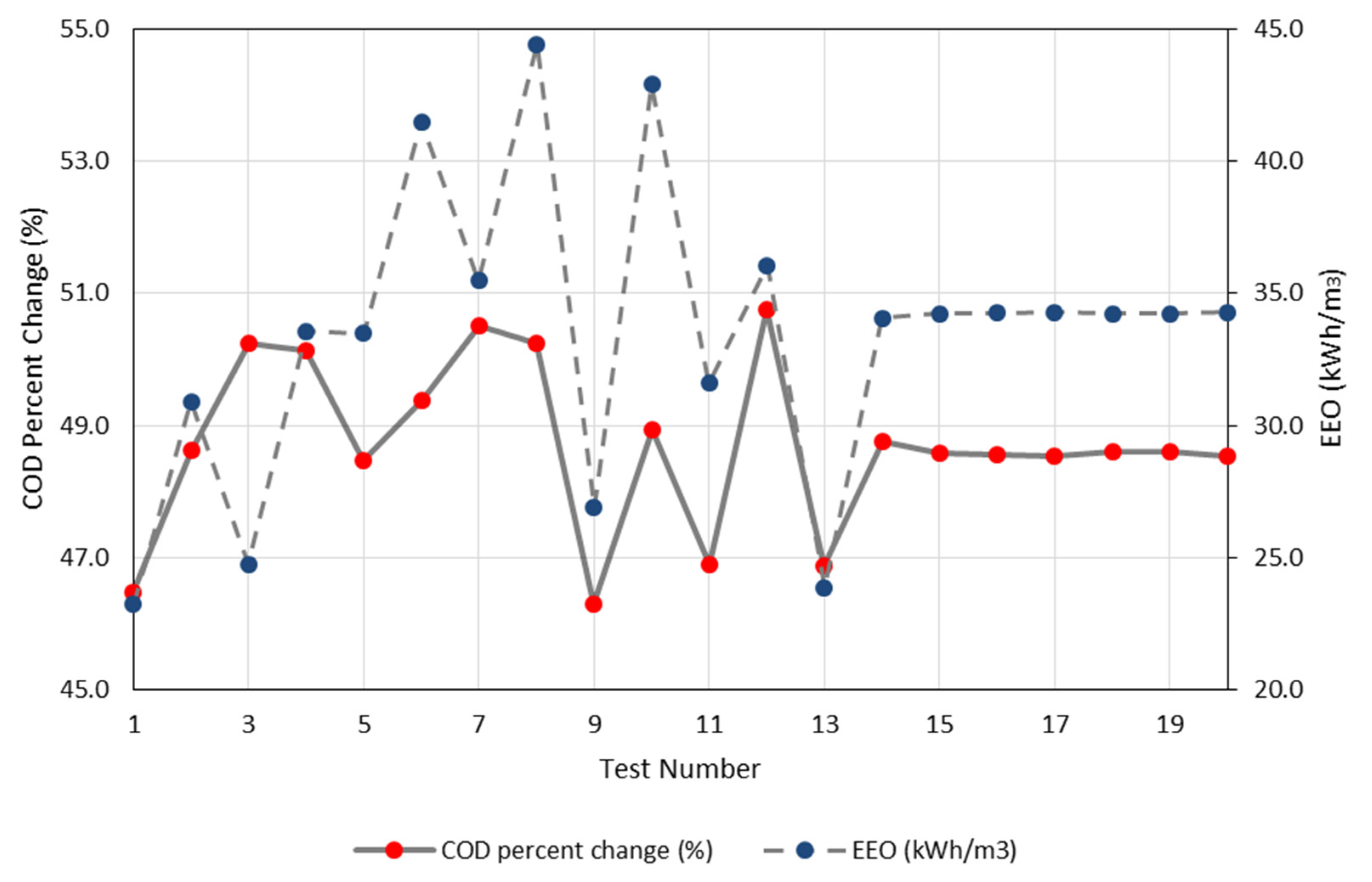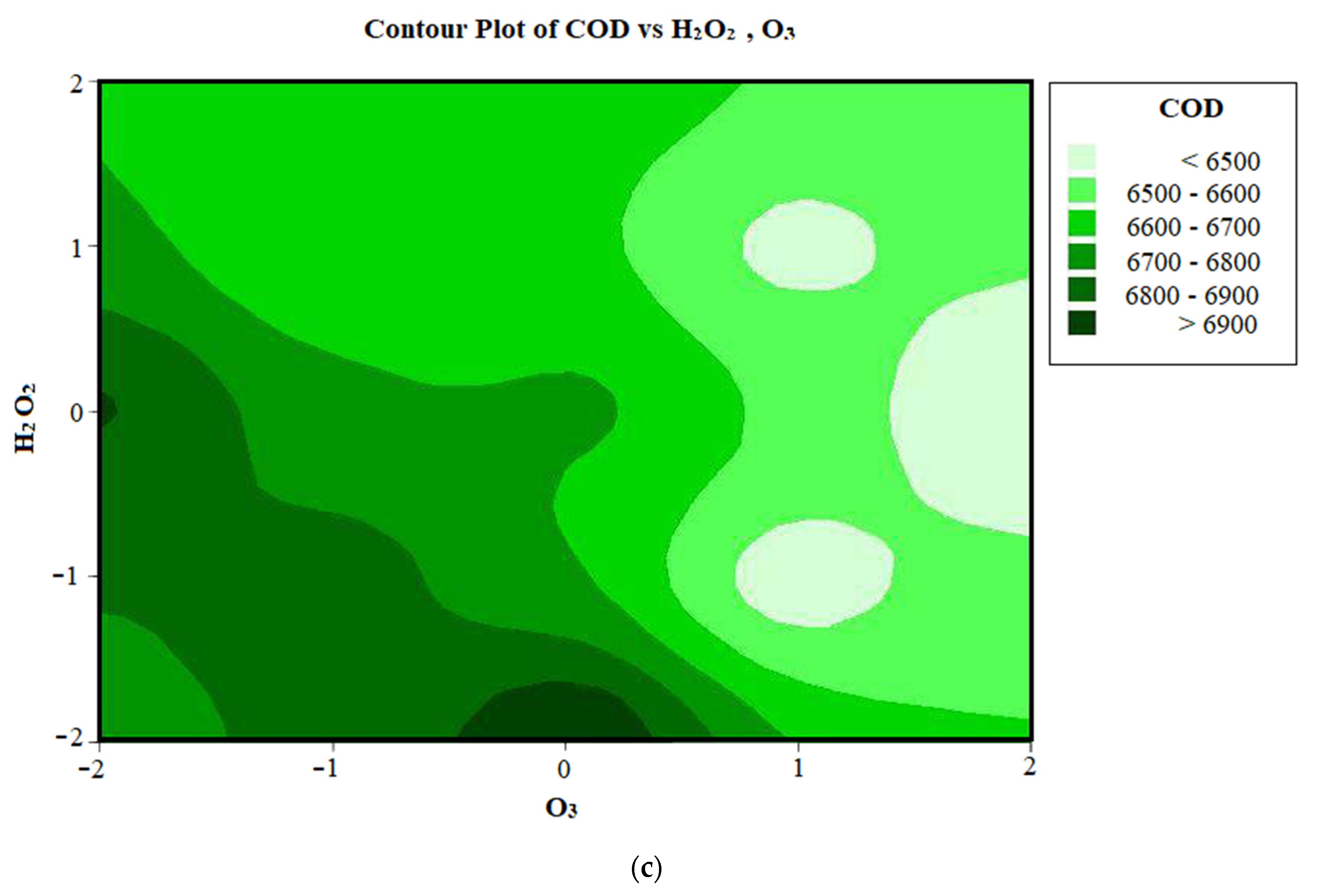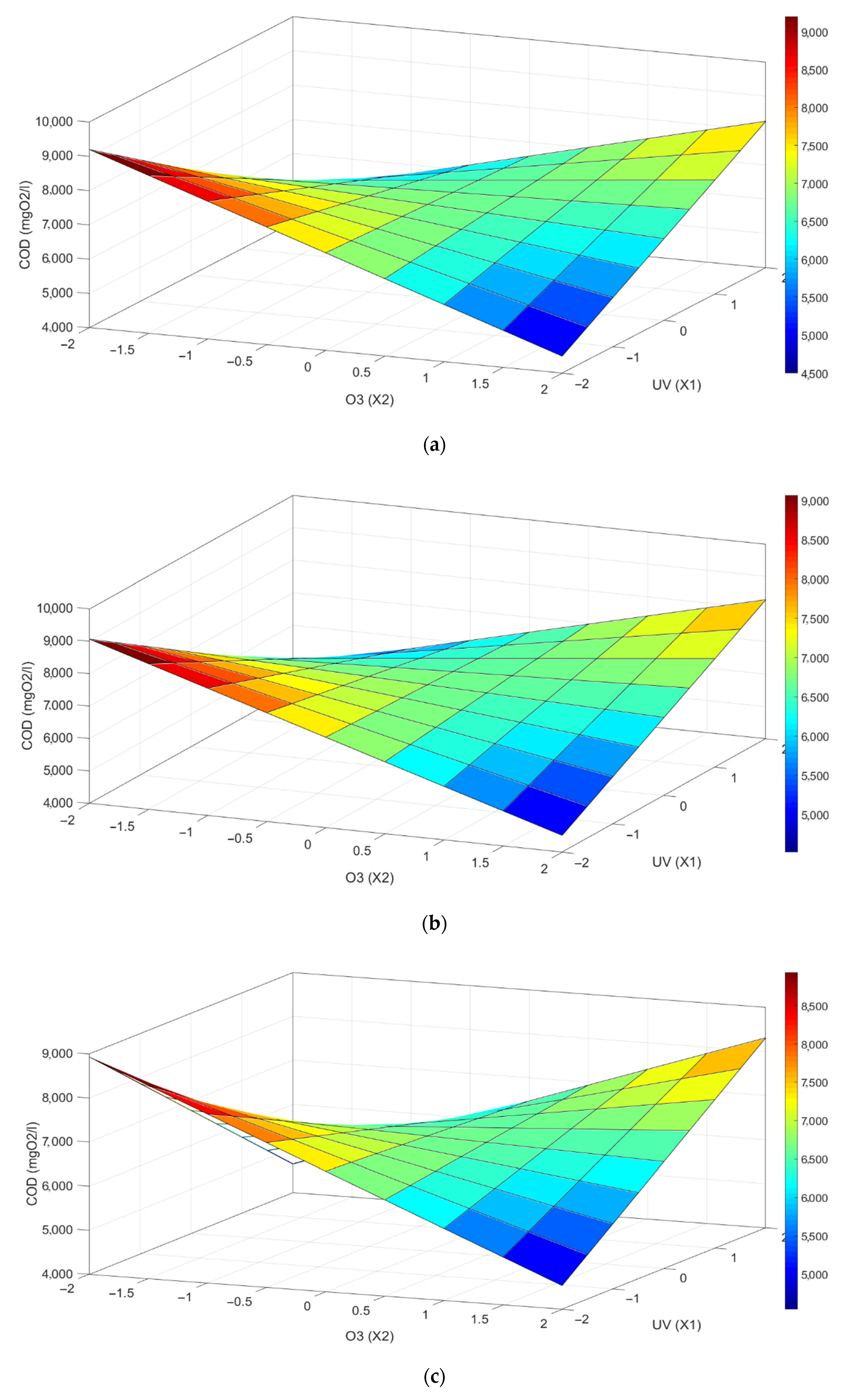COD Reduction of Aeration Effluent by Utilizing Optimum Quantities of UV/H2O2/O3 in a Small-Scale Reactor
Abstract
:1. Introduction
2. Materials and Methods
2.1. The Apparatus
- COD Reactor (Box 389, Loveland, Hach Co., CO, USA)
- Spectrophotometer (Jenway 6305, UV/Vis. Spectrophotometer, UK)
- Centrifuge (Werk NT.BaujharEkin, Universal 320 R, Hettich, Germany)
- Lab oven
- Furnace (Aria-Electric, EMTC model, Iran)
- Ph meter (pH 162, Iran)
- Laboratory scales with measurement accuracy of 0.00001 g (Kyoto Co., Electronic balance, AEL-40SM, Japan)
- Ozone generator (ARDA Ozone- ONE)
- UV bulb (33 W, AQUA SAFE, Taiwan)
- RO Pump (TY-2800- 24 VDC)
2.2. The Input Materials/Chemicals
- Potassium Dichromate (Zigma), 99% (W/W)
- Concentrated sulfuric acid (Merck), 98% (W/W)
- Mercury sulfate (Zigma), 98% (W/W)
- Silver sulfate (Zigma), >99% (W/W)
- Potassium Hydrogen Phthalate (Merck), >99% (W/W)
- Hydrogen peroxide (Merck), >30% (W/W)
2.3. The Studied Wastewater
2.4. Measurement Methods
2.5. Construction of the Base Line
Experimental Conditions
3. Results and Discussion
3.1. Residual Diagrams
3.2. Developed Correlation
3.3. Analyses of the Response’s Surface Plots
3.4. Optimization Conditions
4. Conclusions
Author Contributions
Funding
Institutional Review Board Statement
Informed Consent Statement
Data Availability Statement
Conflicts of Interest
References
- Saffari, P.R.; Salarian, H.; Lohrasbi, A.; Salehi, G.; Manesh, M.H.K. Optimization of a Thermal Cracking Reactor Using Genetic Algorithm and Water Cycle Algorithm. ACS Omega 2022, 7, 12493–12508. [Google Scholar] [CrossRef]
- Rafiee, M.; Salehi, E.; Sharifi, K.; Mohammadi, A.H.; Rohani, A.; Sabeti, M. Enhancement of biogas production efficiency using appropriate low-temperature pretreatments of municipal treatment plants' excess sludge. Environ. Prog. Sustain. Energy 2019, 38, e13072. [Google Scholar] [CrossRef]
- Halder, J.N.; Islam, M.N. Water pollution and its impact on the human health. J. Environ. Hum. 2015, 2, 36–46. [Google Scholar] [CrossRef]
- Ameta, S.C.; Ameta, R. Advanced Oxidation Processes for Wastewater Treatment: Emerging Green Chemical Technology; Academic Press: Cambridge, MA, USA, 2018. [Google Scholar]
- Ganiyu, S.O.; Van Hullebusch, E.D.; Cretin, M.; Esposito, G.; Oturan, M.A. Coupling of membrane filtration and advanced oxidation processes for removal of pharmaceutical residues: A critical review. Sep. Purif. Technol. 2015, 156, 891–914. [Google Scholar] [CrossRef]
- Muruganandham, M.; Swaminathan, M. Advanced oxidative decolourisation of Reactive Yellow 14 azo dye by UV/TiO2, UV/H2O2, UV/H2O2/Fe2+ processes—A comparative study. Sep. Purif. Technol. 2006, 48, 297–303. [Google Scholar] [CrossRef]
- Gorito, A.M.; Pesqueira, J.F.; Moreira, N.F.; Ribeiro, A.R.; Pereira, M.F.R.; Nunes, O.C.; Almeida, C.M.R.; Silva, A.M. Ozone-based water treatment (O3, O3/UV, O3/H2O2) for removal of organic micropollutants, bacteria inactivation and regrowth prevention. J. Environ. Chem. Eng. 2021, 9, 105315. [Google Scholar] [CrossRef]
- Issaka, E.; Amu-Darko, J.N.-O.; Yakubu, S.; Fapohunda, F.O.; Ali, N.; Bilal, M. Advanced catalytic ozonation for degradation of pharmaceutical pollutants―A review. Chemosphere 2022, 289, 133208. [Google Scholar] [CrossRef]
- Mohajerani, M.; Mehrvar, M.; Ein-Mozaffari, F. An overview of the integration of advanced oxidation technologies and other processes for water and wastewater treatment. Int. J. Eng. 2009, 3, 120–146. [Google Scholar]
- Bokare, A.D.; Choi, W. Review of iron-free Fenton-like systems for activating H2O2 in advanced oxidation processes. J. Hazard. Mater. 2014, 275, 121–135. [Google Scholar] [CrossRef]
- Yao, H. Application of advanced oxidation processes for treatment of air from livestock buildings and industrial facilities. Tech. Rep. Biol. Chem. Eng. 2013, 2, 1–36. [Google Scholar]
- Yao, H.; Feilberg, A. Application of Advanced Oxidation Processes for Treatment of Air from Livestock Facilities. In Proceedings of the International Conference on Agricultural Engineering, Aarhus, Denmark, 26 June 2016. [Google Scholar]
- Andreozzi, R.; Caprio, V.; Insola, A.; Marotta, R. Advanced oxidation processes (AOP) for water purification and recovery. Catal. Today 1999, 53, 51–59. [Google Scholar] [CrossRef]
- Cuerda-Correa, E.M.; Alexandre-Franco, M.F.; Fernández-González, C. Advanced oxidation processes for the removal of antibiotics from water. An overview. Water 2019, 12, 102. [Google Scholar] [CrossRef] [Green Version]
- Buthiyappan, A.; Aziz, A.R.A.; Daud, W.M.A.W. Degradation performance and cost implication of UV-integrated advanced oxidation processes for wastewater treatments. Rev. Chem. Eng. 2015, 31, 263–302. [Google Scholar] [CrossRef]
- Madihi-Bidgoli, S.; Asadnezhad, S.; Yaghoot-Nezhad, A.; Hassani, A. Azurobine degradation using Fe2O3@multi-walled carbon nanotube activated peroxymonosulfate (PMS) under UVA-LED irradiation: Performance, mechanism and environmental application. J. Environ. Chem. Eng. 2021, 9, 106660. [Google Scholar] [CrossRef]
- Hassani, A.; Eghbali, P.; Mahdipour, F.; Wacławek, S.; Lin, K.-Y.A.; Ghanbari, F. Insights into the synergistic role of photocatalytic activation of peroxymonosulfate by UVA-LED irradiation over CoFe2O4-rGO nanocomposite towards effective Bisphenol A degradation: Performance, mineralization, and activation mechanism. Chem. Eng. J. 2023, 453, 139556. [Google Scholar] [CrossRef]
- Kommineni, S.; Zoeckler, J.; Stocking, P.; Liang, A.; Flores, R.; Rodriguez, T.; Brown, R.; Brown, A. Advanced Oxidation Processed; Center for Groundwater Restoration and Protection, National Water Research Institute; Academia: San Francisco, CA, USA, 2000. [Google Scholar]
- Karci, A.; Arslan-Alaton, I.; Bekbolet, M.; Ozhan, G.; Alpertunga, B. H2O2/UV-C and Photo-Fenton treatment of a nonylphenol polyethoxylate in synthetic freshwater: Follow-up of degradation products, acute toxicity and genotoxicity. Chem. Eng. J. 2014, 241, 43–51. [Google Scholar] [CrossRef]
- Antonopoulou, M.; Evgenidou, E.; Lambropoulou, D.; Konstantinou, I. A review on advanced oxidation processes for the removal of taste and odor compounds from aqueous media. Water Res. 2014, 53, 215–234. [Google Scholar] [CrossRef]
- Gogate, P.R.; Pandit, A.B. A review of imperative technologies for wastewater treatment I: Oxidation technologies at ambient conditions. Adv. Environ. Res. 2004, 8, 501–551. [Google Scholar] [CrossRef]
- Gogate, P.R.; Pandit, A.B. A review of imperative technologies for wastewater treatment II: Hybrid methods. Adv. Environ. Res. 2004, 8, 553–597. [Google Scholar] [CrossRef]
- Oller, I.; Malato, S.; Sánchez-Pérez, J. Combination of advanced oxidation processes and biological treatments for wastewater decontamination—A review. Sci. Total Environ. 2011, 409, 4141–4166. [Google Scholar] [CrossRef]
- Bezerra, M.A.; Santelli, R.E.; Oliveira, E.P.; Villar, L.S.; Escaleira, L.A. Response surface methodology (RSM) as a tool for optimization in analytical chemistry. Talanta 2008, 76, 965–977. [Google Scholar] [CrossRef] [PubMed]
- Rekhate, C.V.; Srivastava, J.K. Effectiveness of O3/Fe2+/H2O2 process for detoxification of heavy metals in municipal wastewater by using RSM. Chem. Eng. Process. Process Intensif. 2021, 165, 108442. [Google Scholar] [CrossRef]
- Masouleh, S.Y.; Mozaffarian, M.; Dabir, B.; Ramezani, S.F. COD and ammonia removal from landfill leachate by UV/PMS/Fe2+ process: ANN/RSM modeling and optimization. Process Saf. Environ. Prot. 2022, 159, 716–726. [Google Scholar] [CrossRef]
- Rice, E.W.; Baird, R.B.; Eaton, A.D.; Clesceri, L.S. Standard Methods for the Examination of Water and Wastewater; American Public Health Association: Washington, DC, USA, 2012; Volume 10. [Google Scholar]
- Da Silva, G.H.R.; Daniel, L.A.; Contrera, R.C.; Bruning, H. Anaerobic effluent disinfected with ozone/hydrogen peroxide efluente anaeróbio desinfetado com ozônio/peróxido de hidrogênio. Cienc. Y Eng. Sci. Eng. J. 2012, 21, 1–7. [Google Scholar]
- Farooq, S.; Engelbrecht, R.S.; Chian, E.S. Influence of temperature and UV light on disinfection with ozone. Water Res. 1977, 11, 737–741. [Google Scholar] [CrossRef]
- Hassen, A.; Mahrouk, M.; Ouzari, H.; Cherif, M.; Boudabous, A.; Damelincourt, J.J. UV disinfection of treated wastewater in a large-scale pilot plant and inactivation of selected bacteria in a laboratory UV device. Bioresour. Technol. 2000, 74, 141–150. [Google Scholar] [CrossRef]
- Hébert, N.; Gagné, F.; Cejka, P.; Bouchard, B.; Hausler, R.; Cyr, D.; Blaise, C.; Fournier, M. Effects of ozone, ultraviolet and peracetic acid disinfection of a primary-treated municipal effluent on the immune system of rainbow trout (Oncorhynchus mykiss). Comp. Biochem. Physiol. Part C Toxicol. Pharmacol. 2008, 148, 122–127. [Google Scholar] [CrossRef]
- Macauley, J.J.; Qiang, Z.; Adams, C.D.; Surampalli, R.; Mormile, M.R. Disinfection of swine wastewater using chlorine, ultraviolet light and ozone. Water Res. 2006, 40, 2017–2026. [Google Scholar] [CrossRef]
- Rosal, R.; Rodríguez, A.; Perdigón-Melón, J.A.; Petre, A.; García-Calvo, E. Oxidation of dissolved organic matter in the effluent of a sewage treatment plant using ozone combined with hydrogen peroxide (O3/H2O2). Chem. Eng. J. 2009, 149, 311–318. [Google Scholar] [CrossRef]









| The Coded Value | The Dose of UV (mWs/cm2) | The Concentration of O3 (mg/L) | The Concentration of H2O2 (mg/L) |
|---|---|---|---|
| +2 | 400 | 8 | 120 |
| +1 | 310 | 6.5 | 95 |
| 0 | 220 | 5 | 70 |
| −1 | 130 | 3.5 | 45 |
| −2 | 40 | 2 | 20 |
| 90 | 1.5 | 25 |
| The Test Number | The Parameters’ Coded Values | ||
|---|---|---|---|
| X1 | X2 | X3 | |
| 1 | −1 | −1 | −1 |
| 2 | 1 | −1 | −1 |
| 3 | −1 | 1 | −1 |
| 4 | 1 | 1 | −1 |
| 5 | −1 | −1 | 1 |
| 6 | 1 | −1 | 1 |
| 7 | −1 | 1 | 1 |
| 8 | 1 | 1 | 1 |
| 9 | −2 | 0 | 0 |
| 10 | 2 | 0 | 0 |
| 11 | 0 | −2 | 0 |
| 12 | 0 | 2 | 0 |
| 13 | 0 | 0 | −2 |
| 14 | 0 | 0 | 2 |
| 15 | 0 | 0 | 0 |
| 16 | 0 | 0 | 0 |
| 17 | 0 | 0 | 0 |
| 18 | 0 | 0 | 0 |
| 19 | 0 | 0 | 0 |
| 20 | 0 | 0 | 0 |
| The Parameters’ Real Values | ||||||
|---|---|---|---|---|---|---|
| The Test Number | The Dose of UV (mWs/cm2) | The Concentration of O3 (mg/L) | The Concentration of H2O2 (mg/L) | COD after Treatment (mgO2/L) | COD Percent Change (%) | Energy Consumption (kWh/m3) |
| 1 | 130 | 3.5 | 45 | 6960 | 46.5 | 23.2 |
| 2 | 310 | 3.5 | 45 | 6680 | 48.6 | 30.9 |
| 3 | 130 | 6.5 | 45 | 6470 | 50.2 | 24.8 |
| 4 | 310 | 6.5 | 45 | 6485 | 50.1 | 33.5 |
| 5 | 130 | 3.5 | 95 | 6700 | 48.5 | 33.5 |
| 6 | 310 | 3.5 | 95 | 6582 | 49.4 | 41.5 |
| 7 | 130 | 6.5 | 95 | 6435 | 50.5 | 35.5 |
| 8 | 310 | 6.5 | 95 | 6470 | 50.2 | 44.4 |
| 9 | 40 | 5 | 70 | 6985 | 46.3 | 26.9 |
| 10 | 400 | 5 | 70 | 6640 | 48.9 | 42.9 |
| 11 | 220 | 2 | 70 | 6905 | 46.9 | 31.6 |
| 12 | 220 | 8 | 70 | 6405 | 50.7 | 36.1 |
| 13 | 220 | 5 | 20 | 6908 | 46.9 | 23.9 |
| 14 | 220 | 5 | 70 | 6665 | 48.7 | 34.1 |
| 15 | 220 | 5 | 70 | 6687 | 48.6 | 34.2 |
| 16 | 220 | 5 | 70 | 6690 | 48.6 | 34.3 |
| 17 | 220 | 5 | 70 | 6692 | 48.5 | 34.3 |
| 18 | 220 | 5 | 70 | 6685 | 48.6 | 34.2 |
| 19 | 220 | 5 | 70 | 6685 | 48.6 | 34.2 |
| 20 | 220 | 5 | 70 | 6692 | 48.5 | 34.3 |
| Variables | Regression Coefficients | t-Value | p-Value |
|---|---|---|---|
| y-intercept | 6663 | 172.812 | 0.000 |
| X3 = H2O2 (mg/L) | −64.87 | −2.684 | 0.023 |
| X2 = O3 (mg/L) | −128.87 | −5.332 | 0.000 |
| X1 = UV (mWs/cm2) | −55.87 | −2.312 | 0.043 |
| X3 × X3 | 18.47 | 0.958 | 0.361 |
| X2 × X2 | −20.91 | −1.085 | 0.304 |
| X1 × X1 | 11.97 | 0.621 | 0.549 |
| X2 × X3 | 56 | 0.638 | 0.032 |
| X1 × X3 | 22.75 | 0.666 | 0.521 |
| X2 × X1 | 38.5 | 1.126 | 0.028 |
| R2 = 0.83 | ADD = 0.00 | R2(ADJ) = 0.83 | |
| UV (mWs/cm2) | O3 (mg/L) | H2O2 (mg/L) | COD (mgO2/L) after Treatment | COD Percent Change (%) | Energy Consumption (kWh/m3) |
|---|---|---|---|---|---|
| 86 | 8 | 40 | 6313 | 51.5 | 22.7 |
Publisher’s Note: MDPI stays neutral with regard to jurisdictional claims in published maps and institutional affiliations. |
© 2022 by the authors. Licensee MDPI, Basel, Switzerland. This article is an open access article distributed under the terms and conditions of the Creative Commons Attribution (CC BY) license (https://creativecommons.org/licenses/by/4.0/).
Share and Cite
Rafiee, M.; Sabeti, M.; Torabi, F.; Rahimbakhsh, A. COD Reduction of Aeration Effluent by Utilizing Optimum Quantities of UV/H2O2/O3 in a Small-Scale Reactor. Processes 2022, 10, 2441. https://doi.org/10.3390/pr10112441
Rafiee M, Sabeti M, Torabi F, Rahimbakhsh A. COD Reduction of Aeration Effluent by Utilizing Optimum Quantities of UV/H2O2/O3 in a Small-Scale Reactor. Processes. 2022; 10(11):2441. https://doi.org/10.3390/pr10112441
Chicago/Turabian StyleRafiee, Mehdi, Morteza Sabeti, Farshid Torabi, and Aria Rahimbakhsh. 2022. "COD Reduction of Aeration Effluent by Utilizing Optimum Quantities of UV/H2O2/O3 in a Small-Scale Reactor" Processes 10, no. 11: 2441. https://doi.org/10.3390/pr10112441
APA StyleRafiee, M., Sabeti, M., Torabi, F., & Rahimbakhsh, A. (2022). COD Reduction of Aeration Effluent by Utilizing Optimum Quantities of UV/H2O2/O3 in a Small-Scale Reactor. Processes, 10(11), 2441. https://doi.org/10.3390/pr10112441










